Stress-Adaptive Stiffening Structures Inspired by Diatoms: A Parametric Solution for Lightweight Surfaces
Abstract
1. Introduction
2. Materials and Methods
2.1. Experimental Approach
2.2. Reference Model
2.3. Engineering Approach: Thickness Optimization
2.4. Biomimetic Approach: Stress-Adaptive Sandwich Combs
2.4.1. Microscopical Analysis of Diatoms
2.4.2. Comb Studies
2.4.3. Combined Model
2.5. Variation of Boundary Conditions
3. Results
3.1. Reference Model
3.2. Engineering Approach: Thickness Optimization
3.3. Biomimetic Approach: Stress-Adaptive Sandwich Combs
3.3.1. Microscopic Analysis of Diatoms
3.3.2. Comb Studies
3.3.3. Combined Model
3.4. Comparison of the Approaches
3.5. Variation of Boundary Conditions
4. Discussion
4.1. Biomimetic Approach: Stress-Adaptive Sandwich Combs
4.1.1. Microscopic Analysis of Diatoms
4.1.2. Comb Studies
4.1.3. Combined Model
4.2. Comparison of the Results
4.3. Variation of Boundary Conditions
5. Conclusions
Author Contributions
Funding
Institutional Review Board Statement
Data Availability Statement
Acknowledgments
Conflicts of Interest
References
- Round, F.E.; Crawford, R.M.; Mann, D.G. Diatoms: Biology and Morphology of the Genera; Cambridge University Press: Cambridge, UK, 1990; ISBN 978-0-521-36318-1. [Google Scholar]
- Kooistra, W.H.C.F.; Pohl, G. Diatom Frustule Morphology and Its Biomimetic Applications in Architecture and Industrial Design. In Evolution of Lightweight Structures: Analyses and Technical Applications; Biologically-Inspired Systems; Hamm, C., Ed.; Springer: Dordrecht, The Netherlands, 2015; pp. 75–102. ISBN 978-94-017-9398-8. [Google Scholar]
- De Tommasi, E.; Gielis, J.; Rogato, A. Diatom Frustule Morphogenesis and Function: A Multidisciplinary Survey. Mar. Genom. 2017, 35, 1–18. [Google Scholar] [CrossRef] [PubMed]
- Hamm, C.E.; Merkel, R.; Springer, O.; Jurkojc, P.; Maier, C.; Prechtel, K.; Smetacek, V. Architecture and Material Properties of Diatom Shells Provide Effective Mechanical Protection. Nature 2003, 421, 841–843. [Google Scholar] [CrossRef]
- Pondaven, P.; Gallinari, M.; Chollet, S.; Bucciarelli, E.; Sarthou, G.; Schultes, S.; Jean, F. Grazing-Induced Changes in Cell Wall Silicification in a Marine Diatom. Protist 2007, 158, 21–28. [Google Scholar] [CrossRef] [PubMed]
- Renaudie, J. Quantifying the Cenozoic Marine Diatom Deposition History: Links to the C and Si Cycles. Biogeosciences 2016, 13, 6003–6014. [Google Scholar] [CrossRef]
- Hamm, C.E. The Evolution of Advanced Mechanical Defenses and Potential Technological Applications of Diatom Shells. J. Nanosci. Nanotechnol. 2005, 5, 108–119. [Google Scholar] [CrossRef] [PubMed]
- Hamm, C.; Smetacek, V. Armor: Why, When, and How. In Evolution of Primary Producers in the Sea; Elsevier: Amsterdam, The Netherlands, 2007; pp. 311–332. [Google Scholar]
- Aitken, Z.H.; Luo, S.; Reynolds, S.N.; Thaulow, C.; Greer, J.R. Microstructure Provides Insights into Evolutionary Design and Resilience of Coscinodiscus Sp. Frustule. Proc. Natl. Acad. Sci. USA 2016, 113, 2017–2022. [Google Scholar] [CrossRef] [PubMed]
- Cvjetinovic, J.; Luchkin, S.Y.; Statnik, E.S.; Davidovich, N.A.; Somov, P.A.; Salimon, A.I.; Korsunsky, A.M.; Gorin, D.A. Revealing the Static and Dynamic Nanomechanical Properties of Diatom Frustules—Nature’s Glass Lace. Sci. Rep. 2023, 13, 5518. [Google Scholar] [CrossRef] [PubMed]
- Lu, J.; Sun, C.; Wang, Q.J. Mechanical Simulation of a Diatom Frustule Structure. J. Bionic Eng. 2015, 12, 98–108. [Google Scholar] [CrossRef]
- Topal, E.; Rajendran, H.; Zgłobicka, I.; Gluch, J.; Liao, Z.; Clausner, A.; Kurzydłowski, K.J.; Zschech, E. Numerical and Experimental Study of the Mechanical Response of Diatom Frustules. Nanomaterials 2020, 10, 959. [Google Scholar] [CrossRef]
- Zgłobicka, I.; Kurzydłowski, K.J. Multi-Length Scale Characterization of Frustule Showing Highly Hierarchal Structure in the Context of Understanding Their Mechanical Properties. Mater. Today Commun. 2022, 33, 104741. [Google Scholar] [CrossRef]
- Gutiérrez, A.; Guney, M.G.; Fedder, G.K.; Dávila, L.P. The Role of Hierarchical Design and Morphology in the Mechanical Response of Diatom-Inspired Structures via Simulation. Biomater. Sci. 2018, 6, 146–153. [Google Scholar] [CrossRef]
- Maier, M.; Siegel, D.; Thoben, K.-D.; Niebuhr, N.; Hamm, C. Transfer of Natural Micro Structures to Bionic Lightweight Design Proposals. J. Bionic Eng. 2013, 10, 469–478. [Google Scholar] [CrossRef]
- Breish, F.; Hamm, C.; Kienzler, R. Diatom-Inspired Stiffness Optimization for Plates and Cellular Solids. Bioinspiration Biomim. 2023, 18, 036004. [Google Scholar] [CrossRef]
- Al Khalil, M.; Belkebir, H.; Lebaal, N.; Demoly, F.; Roth, S. A Biomimetic Design Method for 3D-Printed Lightweight Structures Using L-Systems and Parametric Optimization. Appl. Sci. 2022, 12, 5530. [Google Scholar] [CrossRef]
- Efstathiadis, A.; Symeonidou, I.; Tsongas, K.; Tzimtzimis, E.K.; Tzetzis, D. Parametric Design and Mechanical Characterization of 3D-Printed PLA Composite Biomimetic Voronoi Lattices Inspired by the Stereom of Sea Urchins. J. Compos. Sci. 2022, 7, 3. [Google Scholar] [CrossRef]
- Alsheghri, A.; Reznikov, N.; Piché, N.; McKee, M.D.; Tamimi, F.; Song, J. Optimization of 3D Network Topology for Bioinspired Design of Stiff and Lightweight Bone-like Structures. Mater. Sci. Eng. C 2021, 123, 112010. [Google Scholar] [CrossRef] [PubMed]
- Monedero, J. Parametric Design: A Review and Some Experiences. Autom. Constr. 2000, 9, 369–377. [Google Scholar] [CrossRef]
- Harding, J.E.; Shepherd, P. Meta-Parametric Design. Des. Stud. 2017, 52, 73–95. [Google Scholar] [CrossRef]
- Pegg, E.C.; Murray, D.W.; Pandit, H.G.; O’Connor, J.J.; Gill, H.S. Fracture of Mobile Unicompartmental Knee Bearings: A Parametric Finite Element Study. Proc. Inst. Mech. Eng. Part H J. Eng. Med. 2013, 227, 1213–1223. [Google Scholar] [CrossRef]
- Hartmann, F.; Katz, C. Structural Analysis with Finite Elements; Springer Science & Business Media: Berlin/Heidelberg, Germany, 2004. [Google Scholar]
- Gross, D.; Hauger, W.; Schnell, W.; Schröder, J.; Wall, W.A. Allgemeine Kraftsysteme und Gleichgewicht des starren Körpers. In Technische Mechanik; Springer-Lehrbuch; Springer: Berlin/Heidelberg, Germany, 2006; pp. 45–88. ISBN 978-3-540-34087-4. [Google Scholar]
- Desclés, J.; Vartanian, M.; El Harrak, A.; Quinet, M.; Bremond, N.; Sapriel, G.; Bibette, J.; Lopez, P.J. New Tools for Labeling Silica in Living Diatoms. New Phytol. 2008, 177, 822–829. [Google Scholar] [CrossRef] [PubMed]
- Ryther, J.H.; Guillard, R.R.L. Studies of Marine Planktonic Diatoms:Ii. Use of Cyclotella Nana Hustedt for Assays of Vitamin B12 in Sea Water. Can. J. Microbiol. 1962, 8, 437–445. [Google Scholar] [CrossRef]
- Aurenhammer, F. Voronoi Diagrams—A Survey of a Fundamental Geometric Data Structure. ACM Comput. Surv. 1991, 23, 345–405. [Google Scholar] [CrossRef]
- Mann, D.G.; Droop, S.J.M. Biodiversity, Biogeography and Conservation of Diatoms. Hydrobiologia 1996, 336, 19–32. [Google Scholar] [CrossRef]
- Burkhardt, B.; Bach, K. Diatoms I, Shells in Nature and Technics; Cramer: Braunschweig, Germany, 1984. [Google Scholar]
- Silva, M.J.; Gibson, L.J. The Effects of Non-Periodic Microstructure and Defects on the Compressive Strength of Two-Dimensional Cellular Solids. Int. J. Mech. Sci. 1997, 39, 549–563. [Google Scholar] [CrossRef]
- Perricone, V.; Grun, T.B.; Rendina, F.; Marmo, F.; Candia Carnevali, M.D.; Kowalewski, M.; Facchini, A.; De Stefano, M.; Santella, L.; Langella, C.; et al. Hexagonal Voronoi Pattern Detected in the Microstructural Design of the Echinoid Skeleton. J. R. Soc. Interface 2022, 19, 20220226. [Google Scholar] [CrossRef] [PubMed]
- Tung, C.-C.; Lai, Y.-Y.; Chen, Y.-Z.; Lin, C.-C.; Chen, P.-Y. Optimization of Mechanical Properties of Bio-Inspired Voronoi Structures by Genetic Algorithm. J. Mater. Res. Technol. 2023, 26, 3813–3829. [Google Scholar] [CrossRef]
- Mattheck, C. The Right Load Distribution: The Axiom of Uniform Stress and Tree Shape. In Design in Nature; Springer: Berlin/Heidelberg, Germany, 1998; pp. 53–114. ISBN 978-3-540-62937-5. [Google Scholar]
- Friedrichs, L.; Hörnig, M.; Schulze, L.; Bertram, A.; Jansen, S.; Hamm, C. Size and Biomechanic Properties of Diatom Frustules Influence Food Uptake by Copepods. Mar. Ecol. Prog. Ser. 2013, 481, 41–51. [Google Scholar] [CrossRef][Green Version]
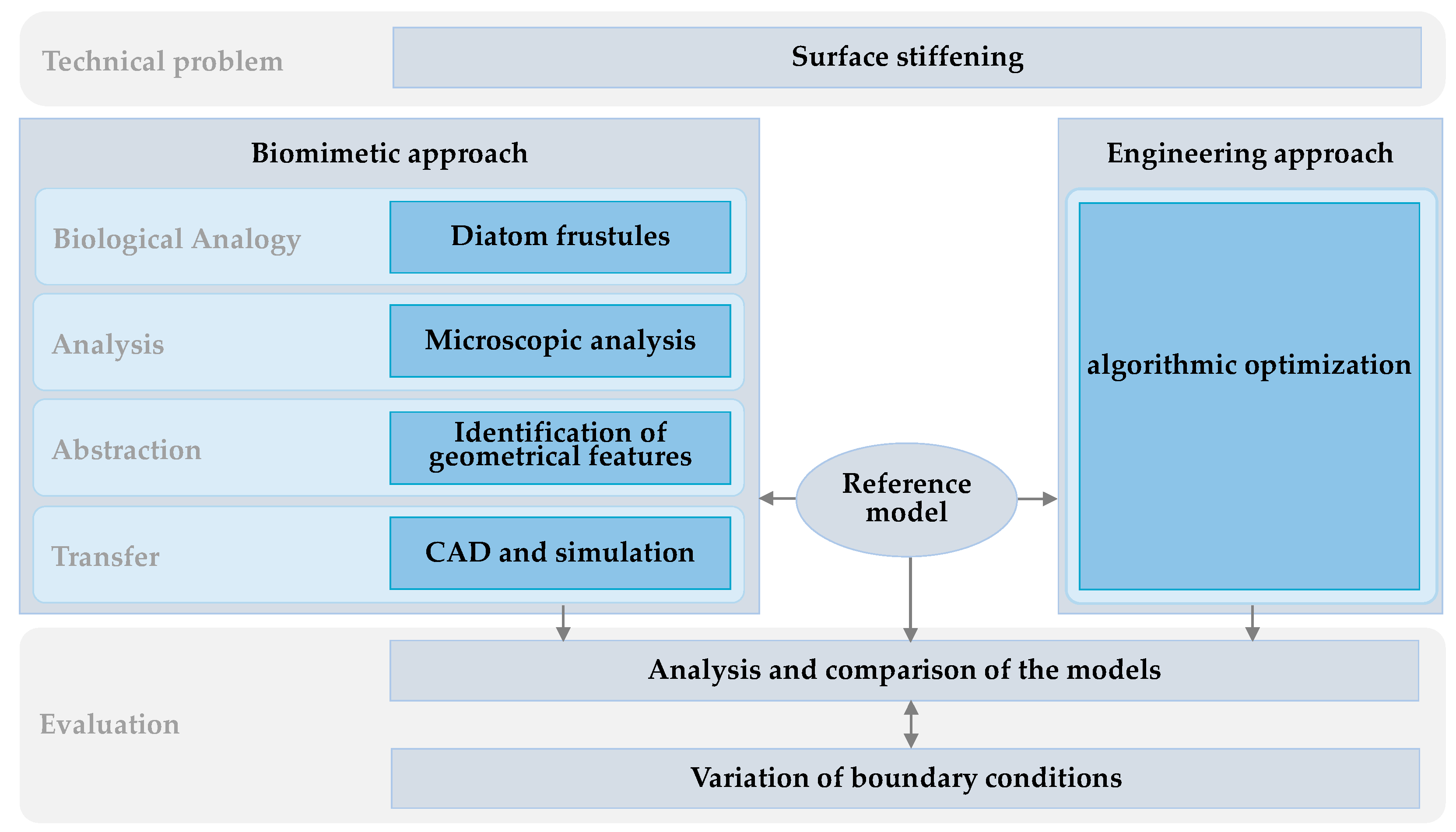
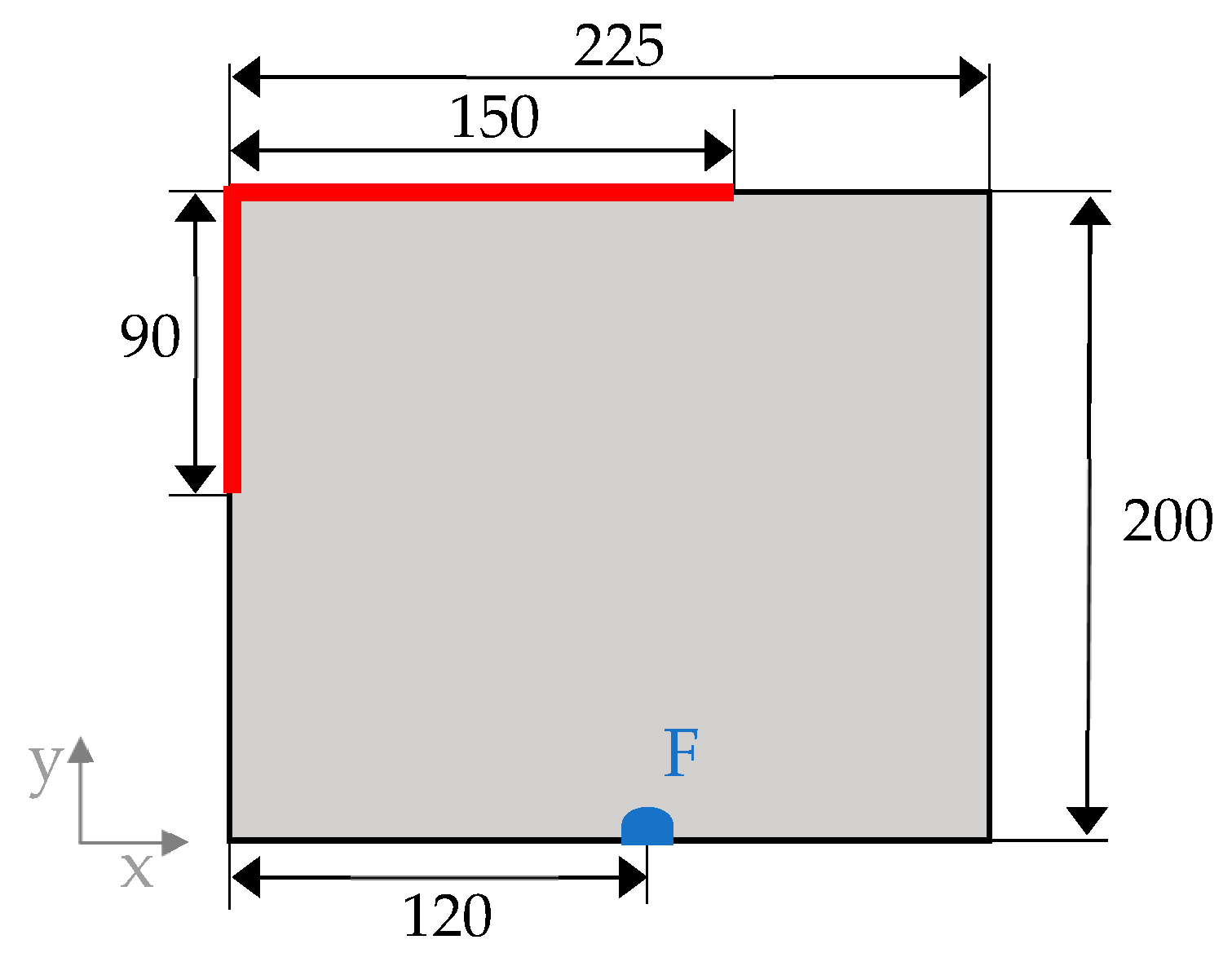

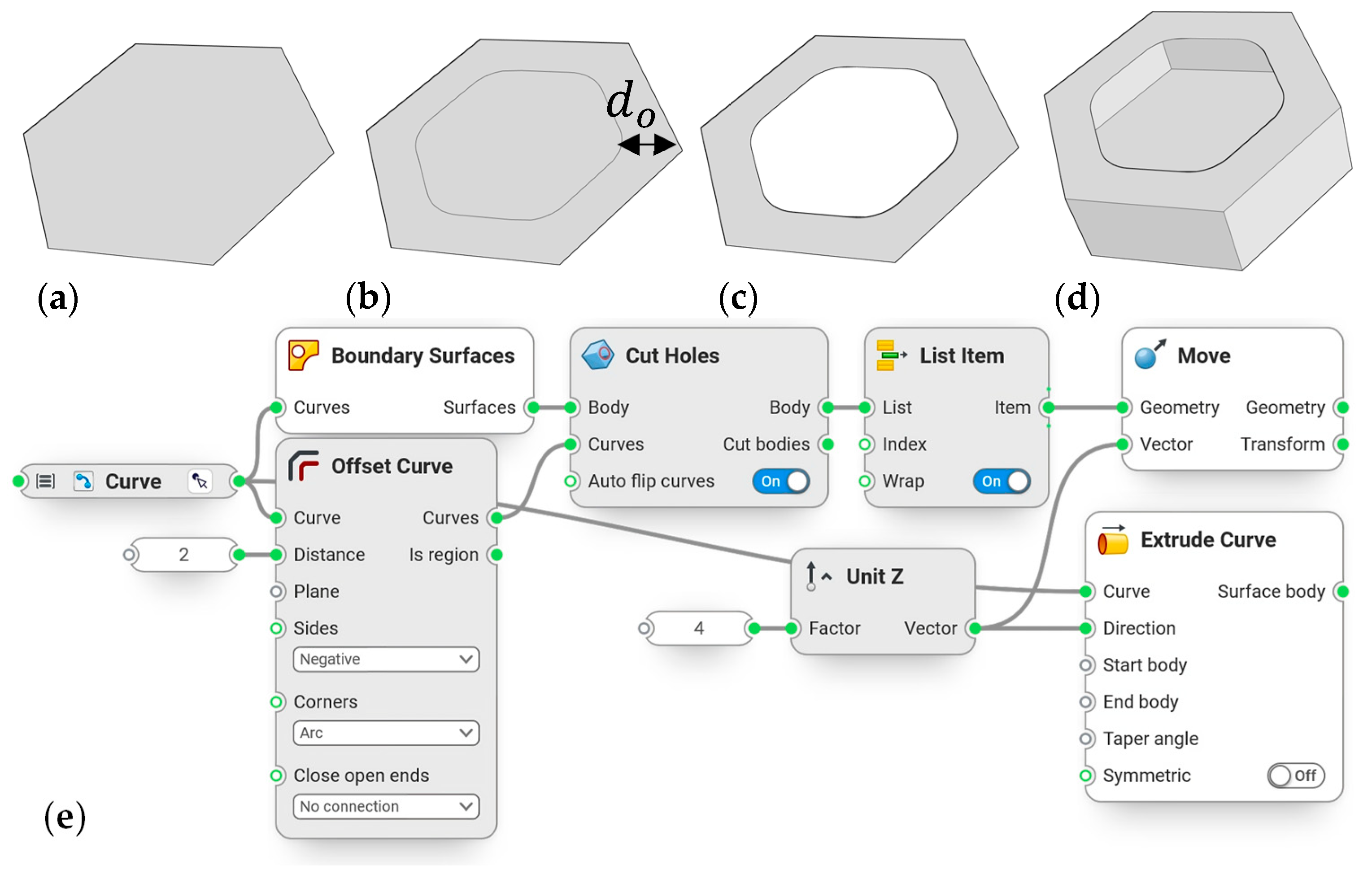

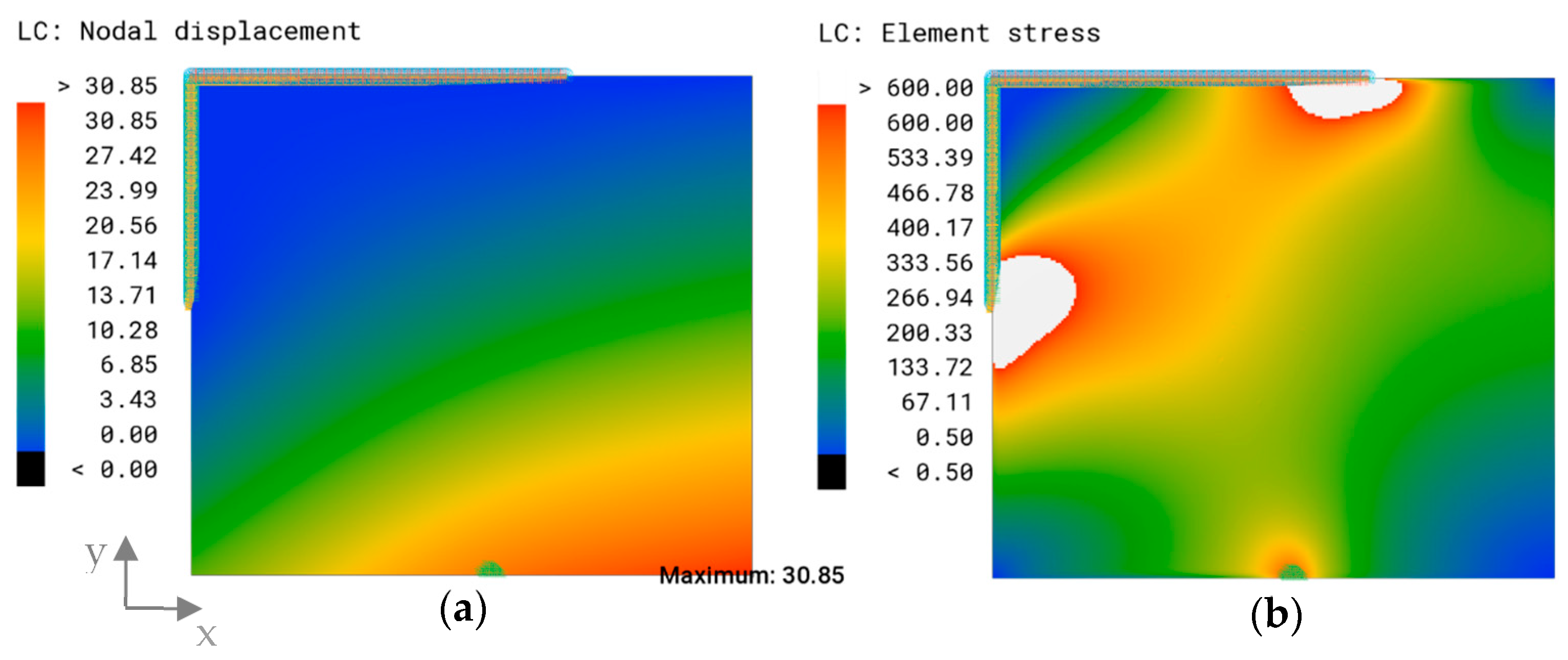

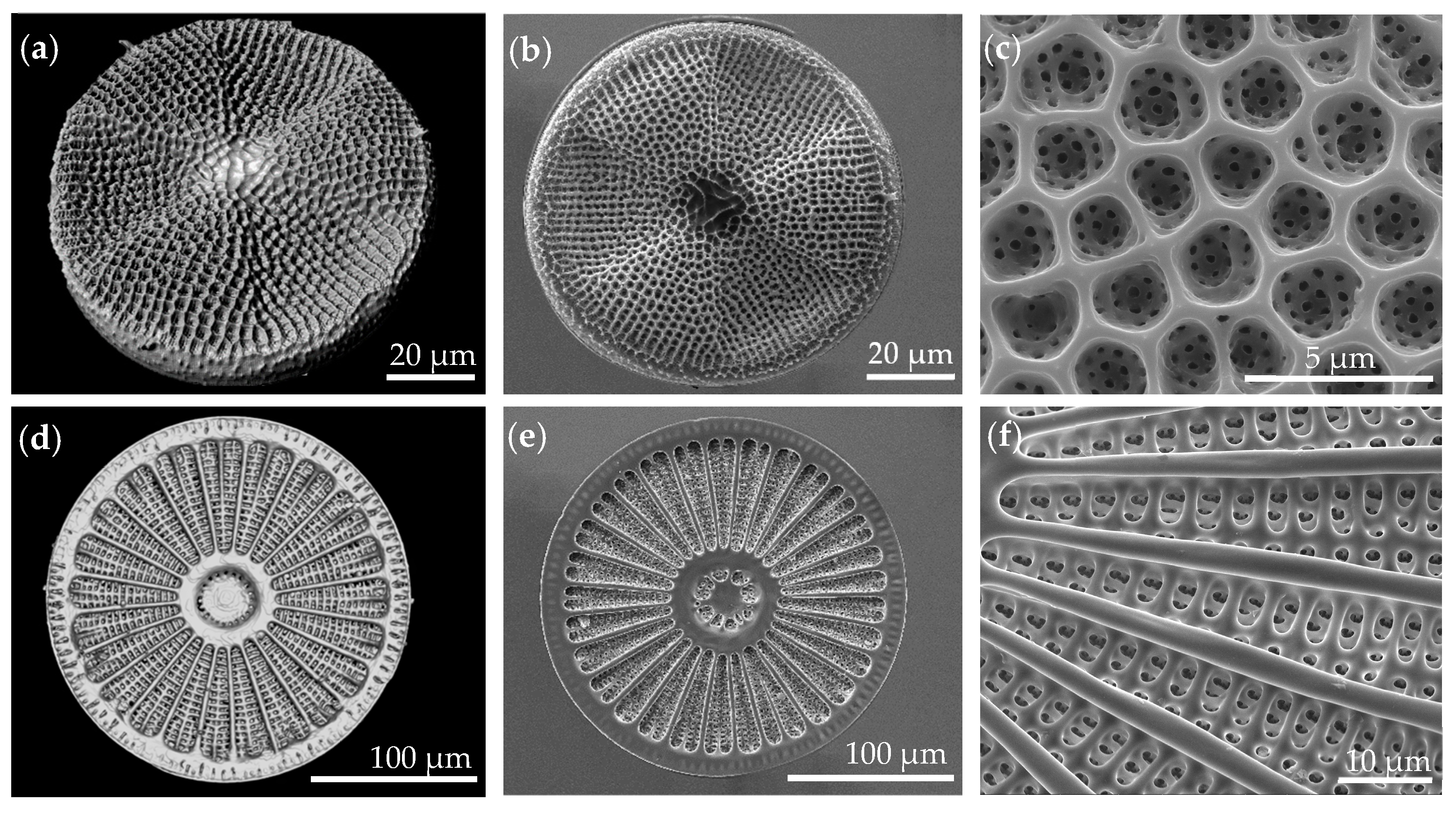
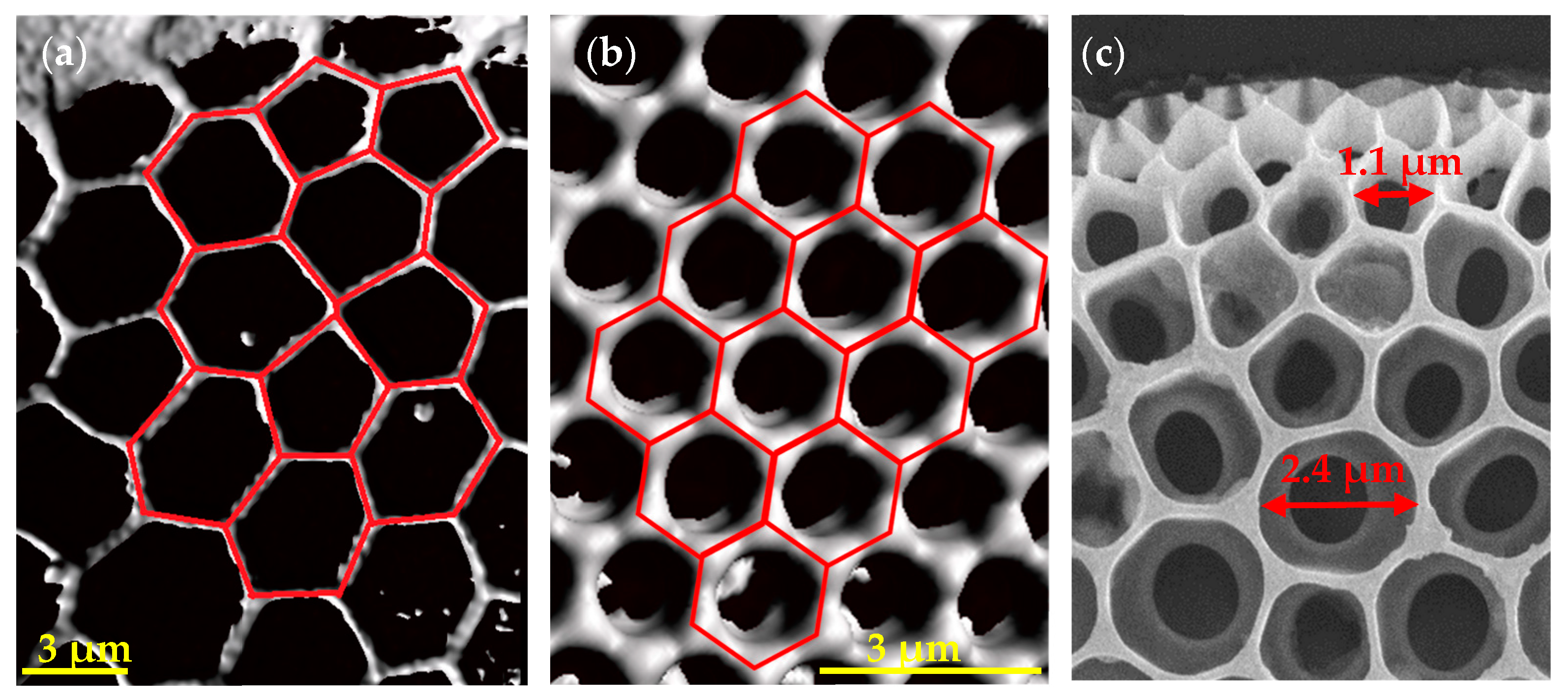

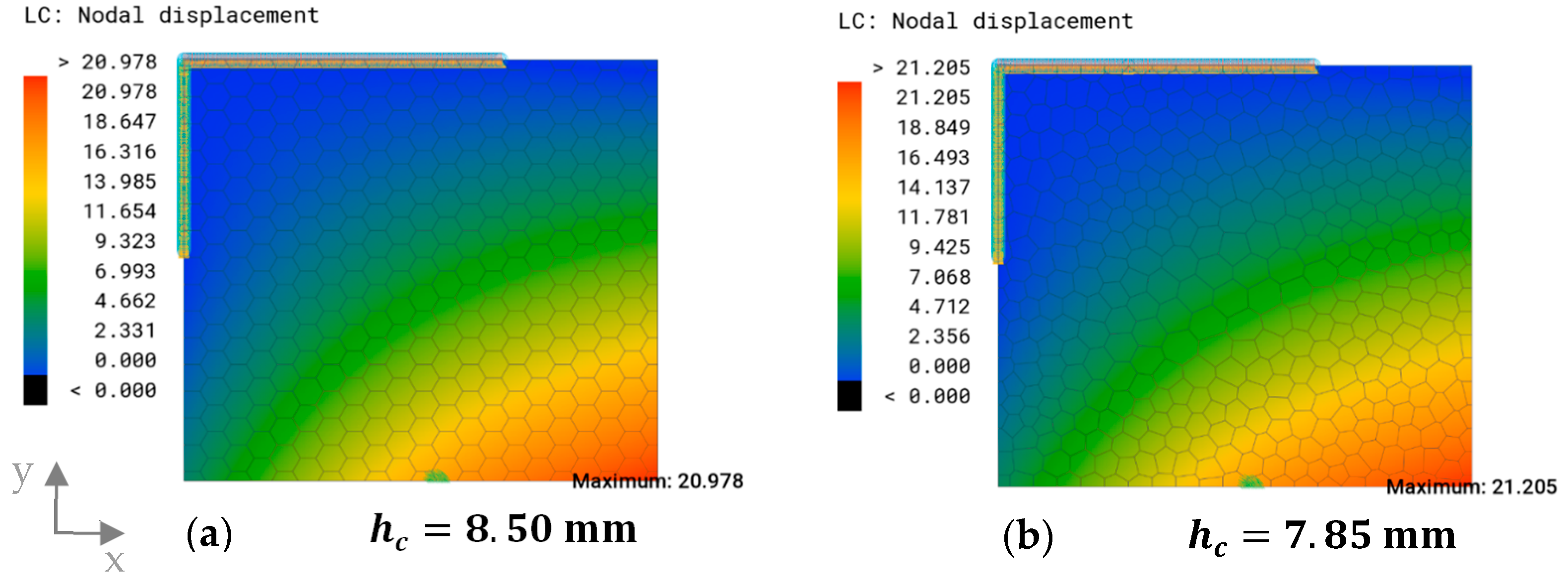
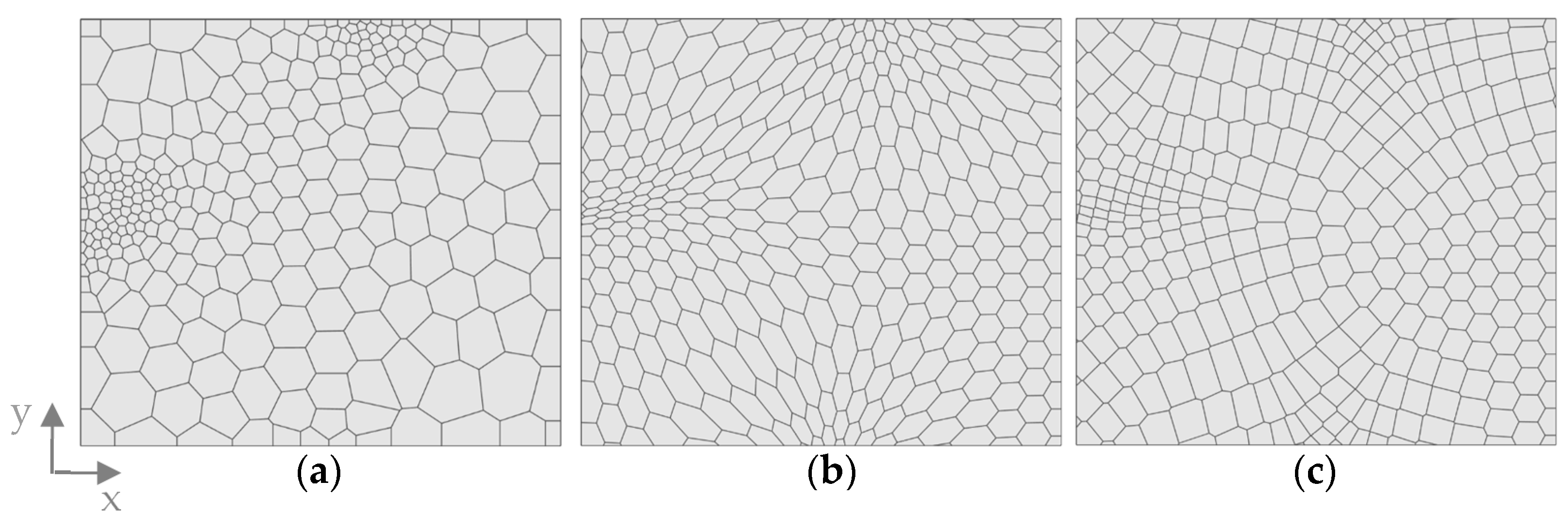
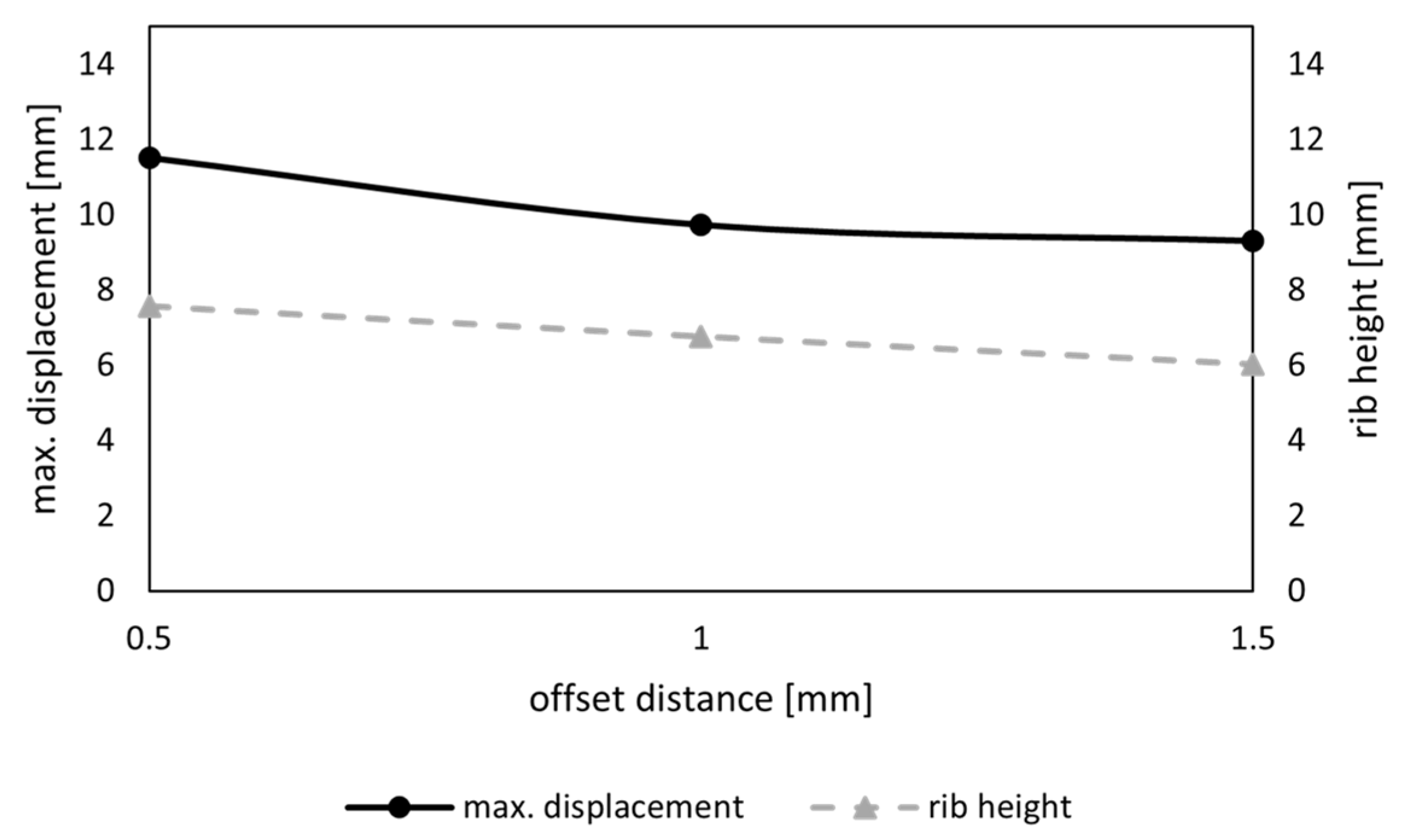
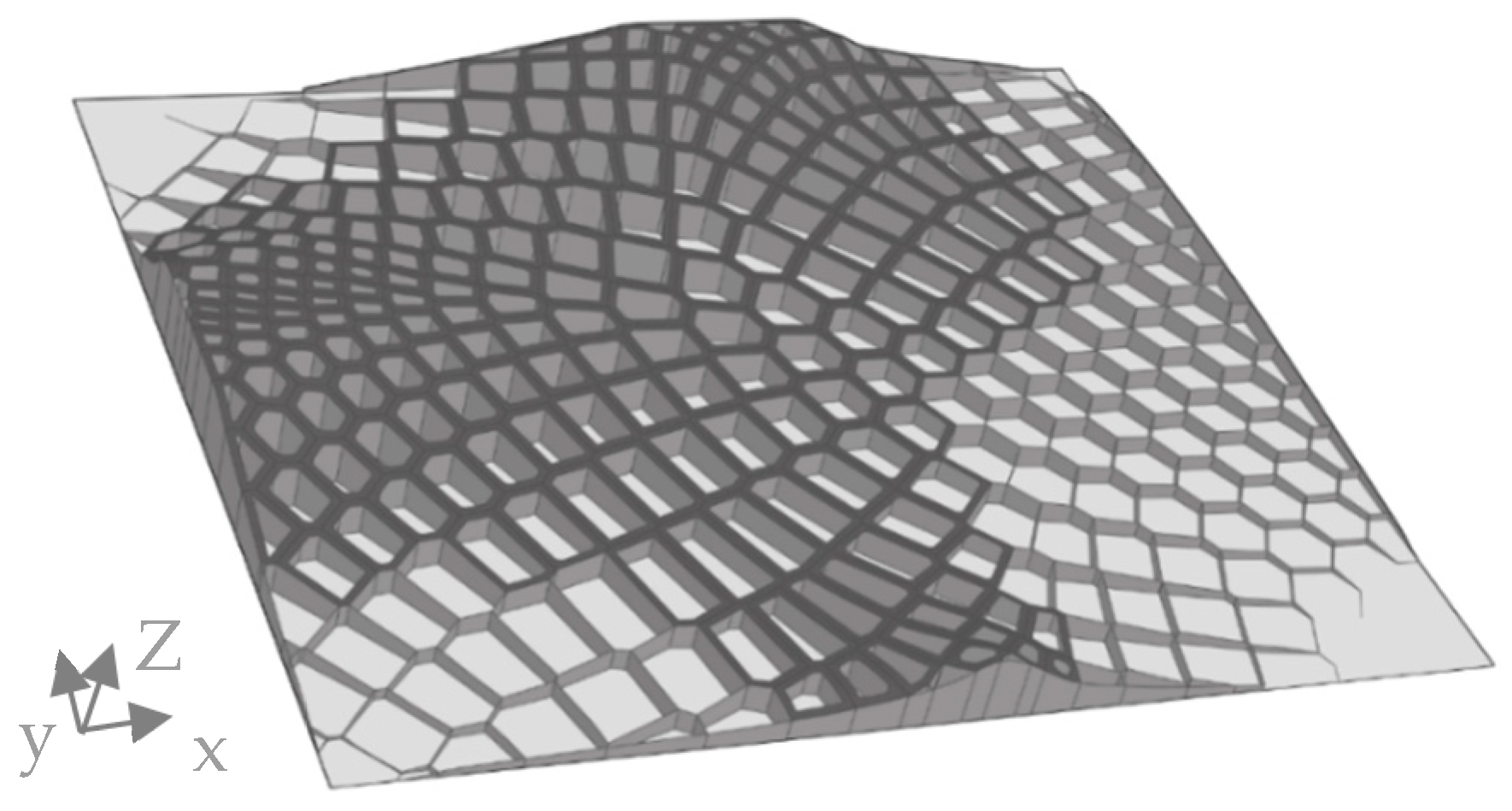
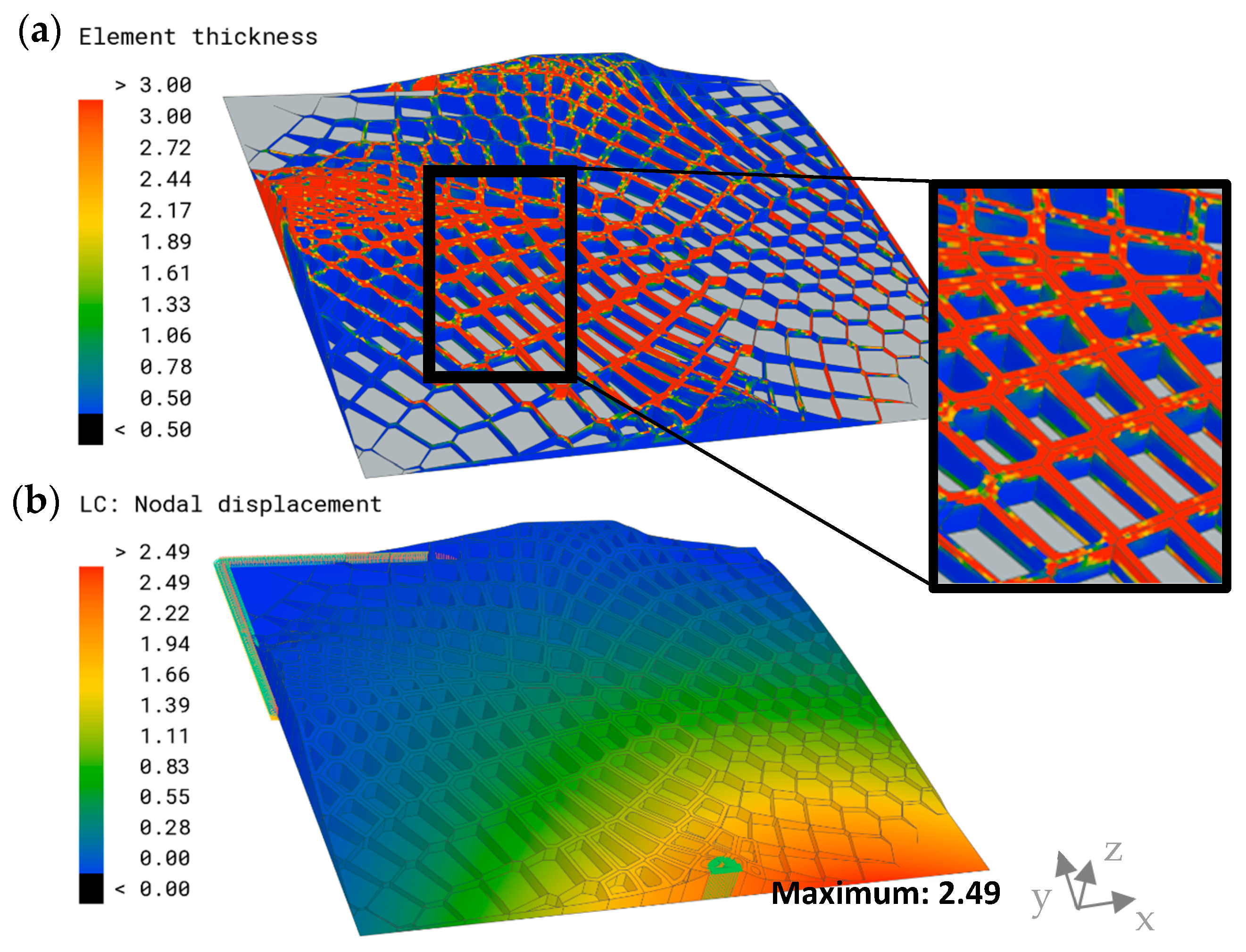
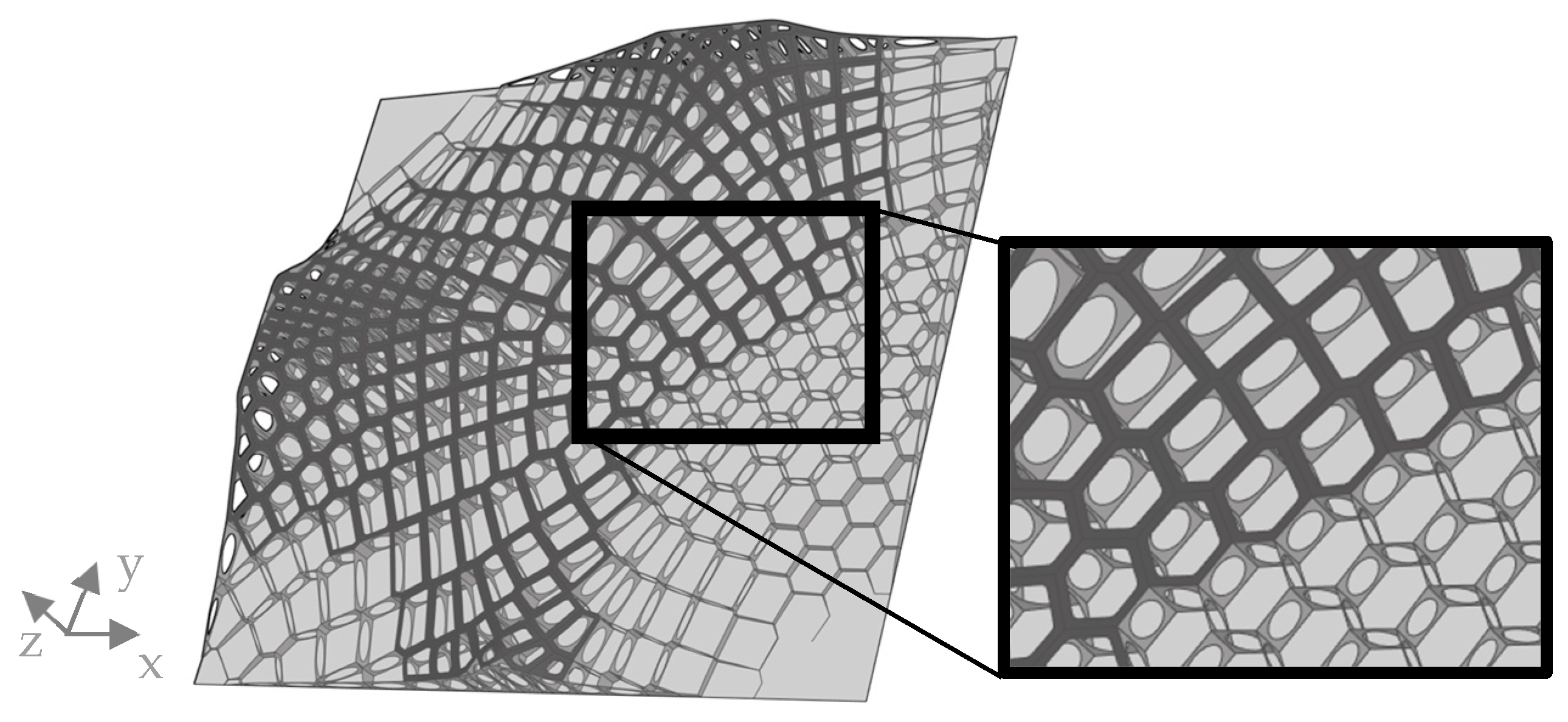
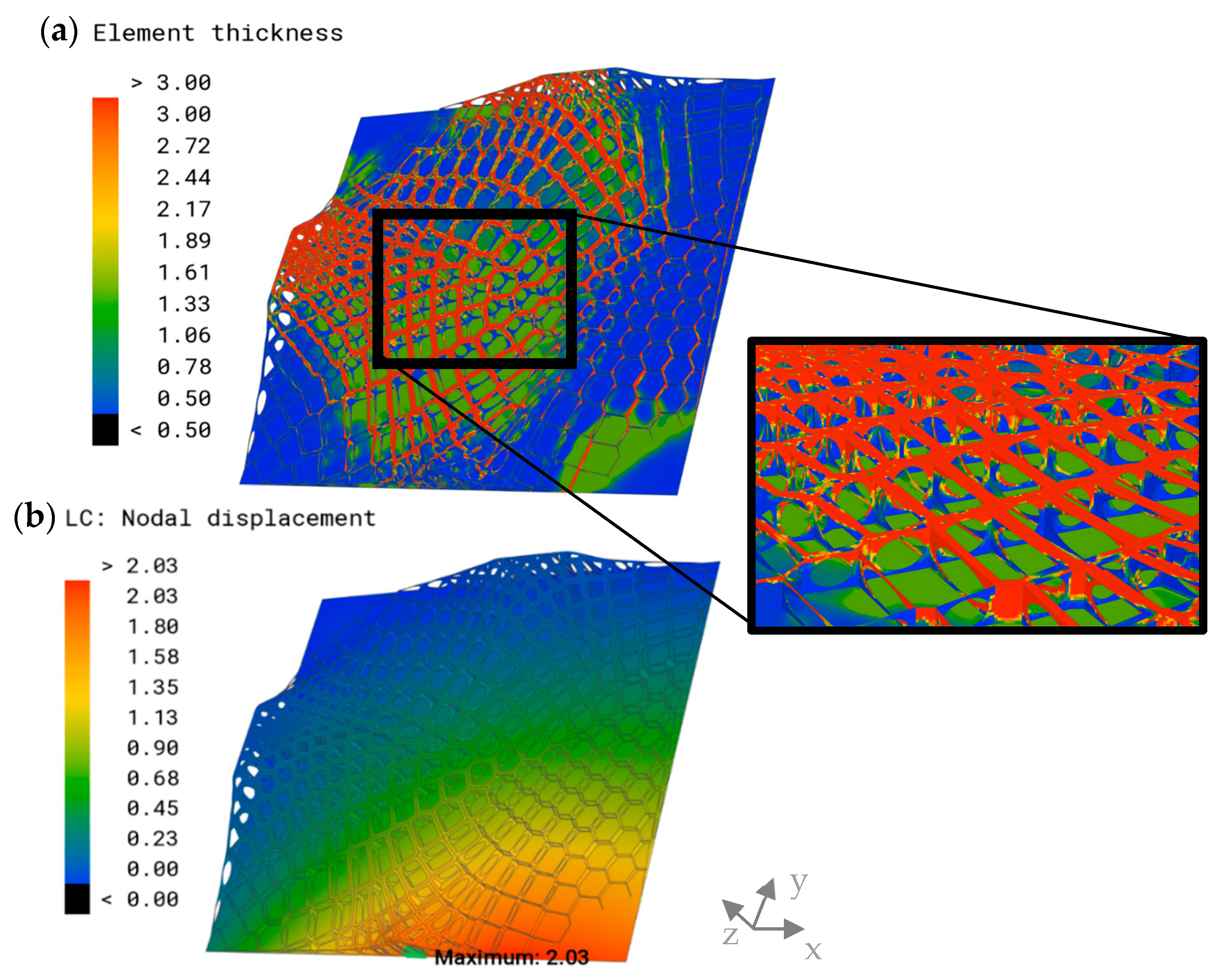
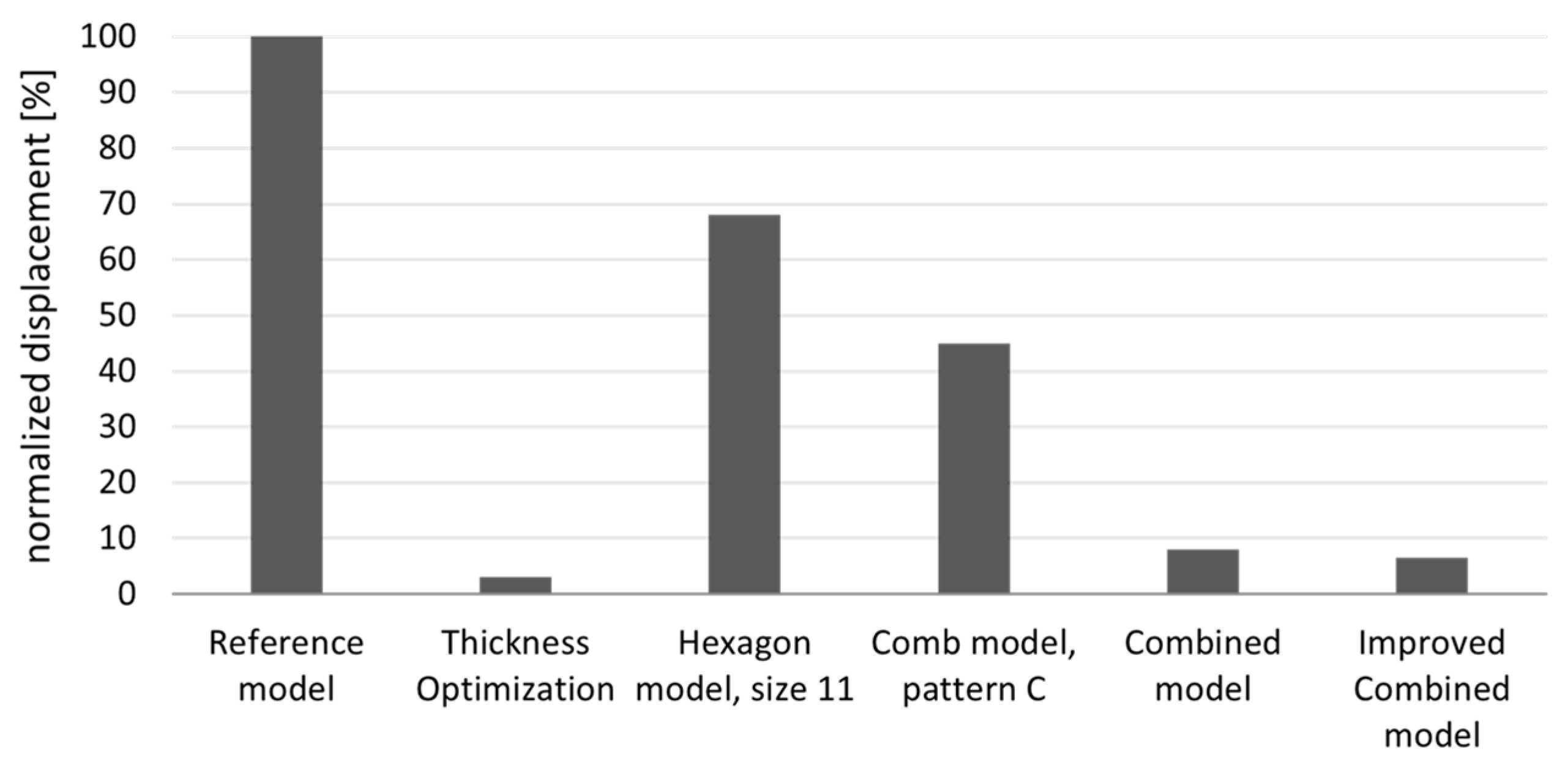

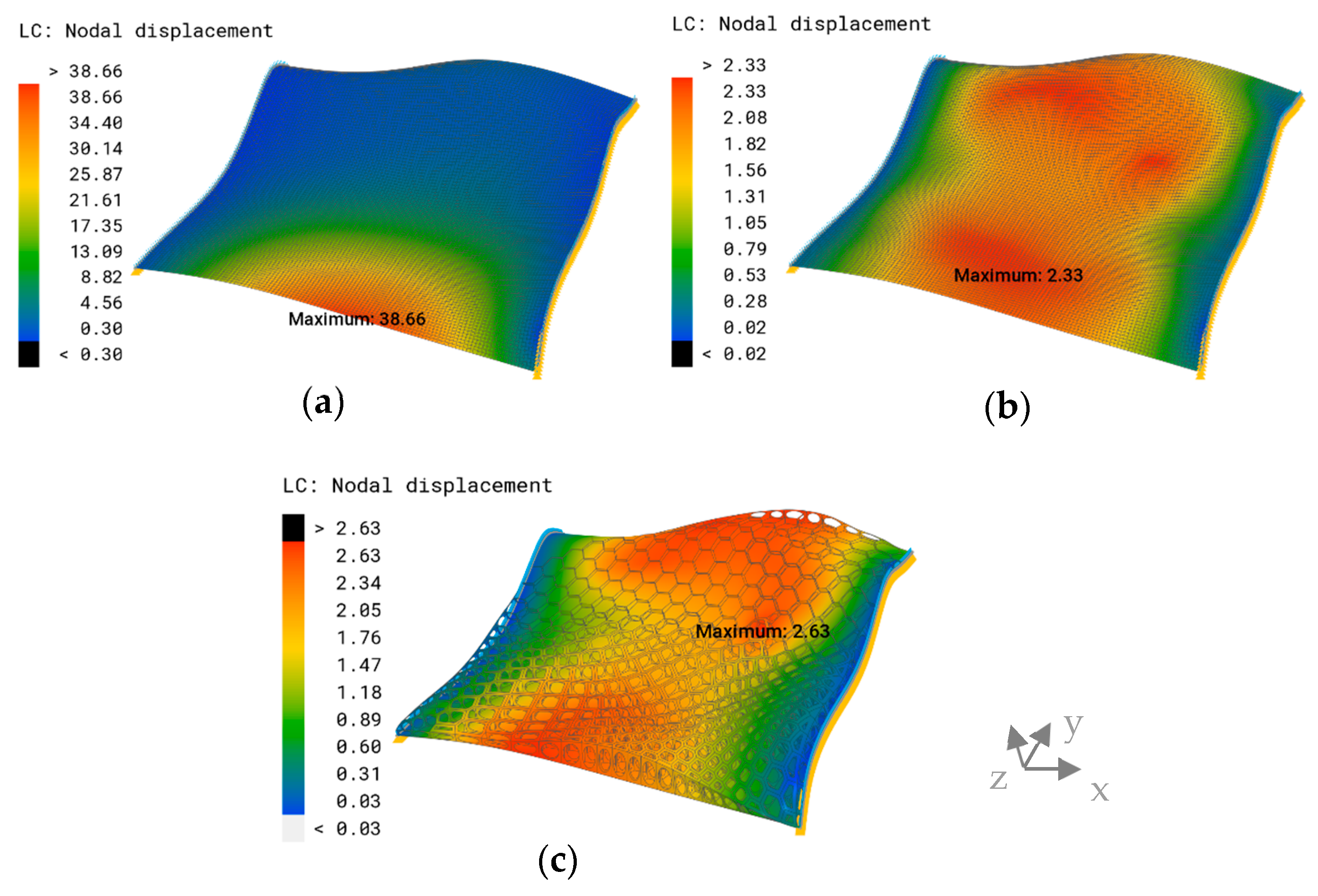

| Property | Value |
|---|---|
| Density [kg m−3] | 8000 |
| Young’s modulus [MPa] | 193,000 |
| Poisson ratio [-] | 0.28 |
| Maximum yield stress [MPa] | 360 |
| [%] | Comb Height (mm) | Sandwich Structure |
|---|---|---|
| <10% | 0 | no |
| 10–40% | 1–15 | no |
| 40–100% | 1–15 | yes |
| Pattern | (mm) | (mm) | |
|---|---|---|---|
| A | 14.80 | 0.71 | 10.30 |
| B | 19.51 | 0.93 | 8.40 |
| C | 13.87 | 0.66 | 8.48 |
Disclaimer/Publisher’s Note: The statements, opinions and data contained in all publications are solely those of the individual author(s) and contributor(s) and not of MDPI and/or the editor(s). MDPI and/or the editor(s) disclaim responsibility for any injury to people or property resulting from any ideas, methods, instructions or products referred to in the content. |
© 2024 by the authors. Licensee MDPI, Basel, Switzerland. This article is an open access article distributed under the terms and conditions of the Creative Commons Attribution (CC BY) license (https://creativecommons.org/licenses/by/4.0/).
Share and Cite
Linnemann, S.K.; Friedrichs, L.; Niebuhr, N.M. Stress-Adaptive Stiffening Structures Inspired by Diatoms: A Parametric Solution for Lightweight Surfaces. Biomimetics 2024, 9, 46. https://doi.org/10.3390/biomimetics9010046
Linnemann SK, Friedrichs L, Niebuhr NM. Stress-Adaptive Stiffening Structures Inspired by Diatoms: A Parametric Solution for Lightweight Surfaces. Biomimetics. 2024; 9(1):46. https://doi.org/10.3390/biomimetics9010046
Chicago/Turabian StyleLinnemann, Selina K., Lars Friedrichs, and Nils M. Niebuhr. 2024. "Stress-Adaptive Stiffening Structures Inspired by Diatoms: A Parametric Solution for Lightweight Surfaces" Biomimetics 9, no. 1: 46. https://doi.org/10.3390/biomimetics9010046
APA StyleLinnemann, S. K., Friedrichs, L., & Niebuhr, N. M. (2024). Stress-Adaptive Stiffening Structures Inspired by Diatoms: A Parametric Solution for Lightweight Surfaces. Biomimetics, 9(1), 46. https://doi.org/10.3390/biomimetics9010046





